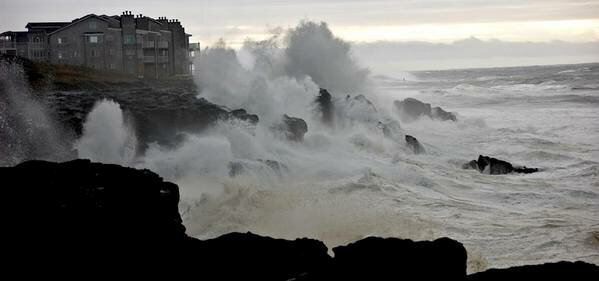Earlier this week I was up at Northgate, and decided to drop in at the Thornton Place complex for the first time. I've been interested in the area ever since Seattle Public Utilities mounted a restoration project for Thornton Creek, which, fed by over 11 square acres, drains into Lake Washington. In former days, the creek had salmon and trout.
The creek has been daylighted, and its banks are coating themselves with greenery, but Thornton Place remains caught between the future its developers (Stellar and Lorig) hoped for and the recessionary one that appeared.
While apartments are renting, some 20 of the condos, which were not selling like hotcakes in the cooling housing market, developed a settling problem that was announced in early April 2010. Today, the 109 condos sit there, empty, aging, and waiting for the other shoe to drop. They're not Lorig's only problem.
In the meantime, Stellar is still looking for commercial clients for its retail space in the complex--they'd love a brewpub, and are considering hosting a farmer's market. And it's not precisely a ghost town: Regal Thornton Place, notes the Seattle Times, is raking in $17.50 per ticket for Shrek 3-D in IMAX.
But there's no denying the feeling you've stumbled onto the set of Life After People when you walk, all by yourself, down the promenade, to your right a revitalized creek pooling and tumbling over rocks, and to your left bare granite-top counters, one after another. Sooner or later, something's got to give.
 From the Autism Speaks website
From the Autism Speaks website
Sallie Tisdale has an article in Harper's (subscribers only) this month about her autistic daughter. There's an element of forestalled explanation to it; yes, she said "daughter."
My daughter, Annie, still lives with us. She is twenty-six now and at the moment is sitting on the porch, looking out at the street. Soon she will come in and pace for a while, her head down. Later she will read the first few pages of a book—the same book, the same pages, that she read last week and the week before, and will read again tomorrow.
"Autistic son" delivers 175,000 results on Google. "Autistic daughter," just 31,000. People are not sure why more boys than girls are found to have autism. Epidemiologically, the ratio is supposed to be about 3.6 boys to one girl.
It's known that girls can learn to mask some of the effects of autism more easily than boys, so it's possible that they are under-diagnosed in general. Studies show that hallmarks like "language deficits, tantrums, and aggression are all less common in girls than boys in the general population." A British researcher raises the specter of a shadow population of "shy" girls who like to keep lists and count calories (even to anorexia).
Tisdale's story is a primer on autism's variability, and its effects on everyone who struggles with it, including caregivers. Tisdale recounts the lifelong challenge of it: the official optimism with which her daughter was handed off as she finished school, the time her daughter started hallucinating and had to be given antipsychotic medication. Writes Tisdale:
Long-term studies of people with autism are not reassuring. Autistic adults generally read poorly, have few math skills. Very few go to college, are employed, or lead independent lives. The majority say they have no friends....
(more)
You know how when you see a flood-prone area hit yet again, and hear it declared a state of emergency? That's not just to attract TV cameras--the declaration means state and federal monies can be made available for home repair, legal services, medical care, and so forth. Depending on the size and frequency of the floods, that can add up to a large bill.
It's also, in part, an answer to the question, "Why do people build in a flood plain?" For one thing, the land is often cheaper than land that doesn't flood. But for another, we help people rebuild. So while there's a risk, you're not paying full freight.
To rectify that last part, FEMA has, for the last five years, been working on developing updated Flood Insurance Rate Maps, which try to assess the risk both in places that flood often, and in places that could flood disastrously. They've created 100,000 individual digital flood insurance rate maps, and, to the chagrin of people who live and work in areas at risk, they don't put a lot of faith in levees or dams.
Insurance is required in some instances where it wasn't before (some money can be saved through a "grandfathering" rule) and new development in a high-risk area is more strictly regulated. The Seattle Times has a story on the outcry across western Washington, even from areas like Chehalis:...
 Waves pound a beach and structure between Depot Bay and Boiler Bay on the Oregon Coast. (Photo by Erica Harris, Oregon State University)
Waves pound a beach and structure between Depot Bay and Boiler Bay on the Oregon Coast. (Photo by Erica Harris, Oregon State University)
Twenty years ago, a big winter storm might generate 25-foot waves offshore of the Pacific Northwest. Scientists pegged 33 feet as the maximum in a 100-year storm. But the intervening years--and a strong El Niño weather pattern--brought 33-foot waves...and then some (see photos here). Now researchers at OSU believe that the maximum wave height in a 100-year event is 46 feet (or as much as 55, depending on how you measure).
The largest wave increase, in fact, centers on the Washington coast, down to northern Oregon, says Science Daily. Wave height has grown about four inches per year, for a total of about ten feet over the past three decades.
"Possible causes might be changes in storm tracks, higher winds, more intense winter storms, or other factors," Ruggiero said. "These probably are related to global warming, but could also be involved with periodic climate fluctuations such as the Pacific Decadal Oscillation, and our wave records are sufficiently short that we can't be certain yet. But what is clear is the waves are getting larger."
The change is a boon to storm watchers and shutterbugs, but the mundane result is coastal erosion that occurs two to three times faster than normal. That, in conjunction with the ongoing sea level rise from climate change, argues the NPI Advocate, means real money, as coastal development is damaged and roads wash away....




Most Recent Comments